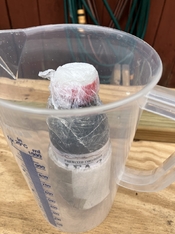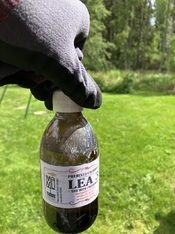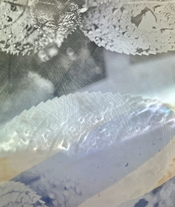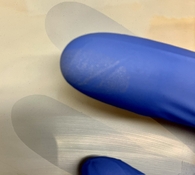You are using an out of date browser. It may not display this or other websites correctly.
You should upgrade or use an alternative browser.
You should upgrade or use an alternative browser.
Bad collodium?
-
A
- Thread starter -chrille-
- Start date
Recent Classifieds
-
For Sale 9 Rolls FUJI Fujifilm SUPERIA PREMIUM 400 27 exp 3 pro packs
- Started by orbitaldebris
-
For Sale Nikon Nikkor-H 85mm f1.8 AI'd
- Started by Oldwino
-
For Sale DAHLE 552 (20-inch) Trimmer
- Started by Renato Tonelli
-
Sold Leica M2 Camera ("Body Button", No Self-Timer Type) CLA'D
- Started by Renato Tonelli
-
For Sale Agfa Super Isolette CLA'd Medium Format 6x6
- Started by Oldwino
Forum statistics
The white mess is probably just dried collodion around the cap where it has leaked. As long as the contents of the bottle still run freely and there are no bits drifting in it, it's likely OK.
I would contact Impex about the packaging problem because this isn't supposed to happen obviously.
I would contact Impex about the packaging problem because this isn't supposed to happen obviously.
That doesn't look too bad. Even the label is still OK! Apparently they don't inkjet print those labels, otherwise it would have been one big smear.
You can probably peel off the white film and everything will look just fine. Looks like only a tiny bit escaped from the bottle.
I'm curious to hear what differences you note between the collodion mixes!
You can probably peel off the white film and everything will look just fine. Looks like only a tiny bit escaped from the bottle.
I'm curious to hear what differences you note between the collodion mixes!
Good to hear And, as always, greatly appreciate your fast and helpfull replies, koraks.
And, as always, greatly appreciate your fast and helpfull replies, koraks.
Yes, will give a report with my experience of collodion mixtures. This one is an all cadmium salts collodium with great shelf life.
 And, as always, greatly appreciate your fast and helpfull replies, koraks.
And, as always, greatly appreciate your fast and helpfull replies, koraks.Yes, will give a report with my experience of collodion mixtures. This one is an all cadmium salts collodium with great shelf life.
This collodion was very easy to pour and make clean plates. I got my best plates so far with it.
Unfortunately I got what I think is veiling on my plates. In the book Chemical Pictures by Quinn Jacobson I read it is because of over developing or a too active developer. So nothing to blame this bottle of collodion for. Nothing wrong with Mamut Photos Lea no 3 then
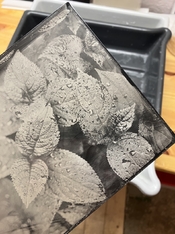
Unfortunately I got what I think is veiling on my plates. In the book Chemical Pictures by Quinn Jacobson I read it is because of over developing or a too active developer. So nothing to blame this bottle of collodion for. Nothing wrong with Mamut Photos Lea no 3 then


That's a nice plate!

These brush marks suggest insufficient cleaning of the plate, leaving a residue that results in local fog in the pattern the plate was wiped before pouring it. How do you clean these plates?
If fogging problems are persistent, you could try reducing the pH of the silver bath. It also comes at the cost of speed/shadow detail, however. Some people also are very adamant that it's not necessary to add e.g. a little nitric acid to get rid of fog. It worked for me, though.
These brush marks suggest insufficient cleaning of the plate, leaving a residue that results in local fog in the pattern the plate was wiped before pouring it. How do you clean these plates?
If fogging problems are persistent, you could try reducing the pH of the silver bath. It also comes at the cost of speed/shadow detail, however. Some people also are very adamant that it's not necessary to add e.g. a little nitric acid to get rid of fog. It worked for me, though.
Yes, it looks like a dirty plate but it is possible to remove it with a cotton pad or gloved finger after fixing. Its like a silver dust. I tought it is veiling but I might be wrong.
I clean my plate with dish soap and let the plates dry. Then I use a premixed glass cleaning solution with witening, alcohol and destilled water. I use papper tissues and rub the solution till it is like a dry powder. Change to a clean paper tissue and rub the powder away. When I hear the ”squeaky” sound from the glass plate I am done. Before pouring the plate I just use a rocket blower to remove any dust.
I clean my plate with dish soap and let the plates dry. Then I use a premixed glass cleaning solution with witening, alcohol and destilled water. I use papper tissues and rub the solution till it is like a dry powder. Change to a clean paper tissue and rub the powder away. When I hear the ”squeaky” sound from the glass plate I am done. Before pouring the plate I just use a rocket blower to remove any dust.
Attachments
OK, thanks for clearing up the cleaning schedule. When I did it the way you described, remnants of whiting caused veiling. Try rinsing the plates under a running tap after you've scrubbed them with whiting + alcohol, while gently brushing the plate with a clean/gloved finger to remove all traces of whiting. Against a dark background, you will be able to see the veil of whitening that is left especially as you start removing it, as the contrast between the clean and still covered areas is clearer.
When rinsing, you can also brush off the whiting that tends to lodge itself in the coarse edges of the plate. This prevents the 'oysters' one sometimes gets along the edges of the image (especially with home-cut glass).
When rinsing, you can also brush off the whiting that tends to lodge itself in the coarse edges of the plate. This prevents the 'oysters' one sometimes gets along the edges of the image (especially with home-cut glass).
Let me know how they turn out; I hope my suggestions help some!
Btw, I still clean my glass plates in a similar way for e.g. carbon transfer on glass. My cleaning regime is usually as follows:
* Cut glass to size and grind down sharp edges with a whetstone.
* Wash glass with a sponge and soapy water. I use generic handsoap from a dispenser.
* Drop some whiting (calcium carbonate) onto the glass and rub it around with wet cloth. I rub in circles until I've thoroughly gone over the entire surface. I don't use alcohol and don't rub until dry as I find neither is necessary to get a perfectly clean and grease-free surface.
* Hold the plate under a running tap and gently wipe across the entire surface and the edges to remove the traces of whiting.
* Set to dry, or if in a hurry, dry the plate with a clean towel.
* Before use, blow dust off or wipe it off with a lint-free cloth.
Works every time, for every purpose.
Btw, I still clean my glass plates in a similar way for e.g. carbon transfer on glass. My cleaning regime is usually as follows:
* Cut glass to size and grind down sharp edges with a whetstone.
* Wash glass with a sponge and soapy water. I use generic handsoap from a dispenser.
* Drop some whiting (calcium carbonate) onto the glass and rub it around with wet cloth. I rub in circles until I've thoroughly gone over the entire surface. I don't use alcohol and don't rub until dry as I find neither is necessary to get a perfectly clean and grease-free surface.
* Hold the plate under a running tap and gently wipe across the entire surface and the edges to remove the traces of whiting.
* Set to dry, or if in a hurry, dry the plate with a clean towel.
* Before use, blow dust off or wipe it off with a lint-free cloth.
Works every time, for every purpose.
I did as described, koraks, and washed away the whiting with water. I also washed the plates in demineralized water after and let the plates dry. Now we are talking clean plates
I shot two plates yesterday.
One with this collodion, Mamut Photos Lea 3 (cadmium bromide and cadmium iodine) and the other plate with Analog Inside Lea no 7 (cadmium bromide and cadmium iodine + ammonium bromide and ammonium iodine)
Still, I got heavy fogging/veiling with this Lea no 3 collodion. But not with the other collodion.
I shot the same subject. Same camera settings, light(indoor) and time in silver bath. Developed the plate until it shown approximately the same shadow detail so some seconds difference between plates in developer. A very unscientific test, I know.
Here are the results:
Analog Inside Lea no 7. Pitch black background, no trace of fogging/veiling.
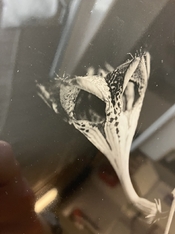
Mamut Photos Lea no 3. Lots of fogging/veiling. A grey background without any deep blacks.
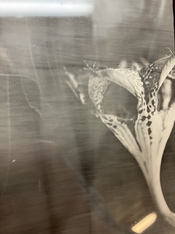
Do you know what is causing this? I dont think the plates are dirty.

I shot two plates yesterday.
One with this collodion, Mamut Photos Lea 3 (cadmium bromide and cadmium iodine) and the other plate with Analog Inside Lea no 7 (cadmium bromide and cadmium iodine + ammonium bromide and ammonium iodine)
Still, I got heavy fogging/veiling with this Lea no 3 collodion. But not with the other collodion.
I shot the same subject. Same camera settings, light(indoor) and time in silver bath. Developed the plate until it shown approximately the same shadow detail so some seconds difference between plates in developer. A very unscientific test, I know.
Here are the results:
Analog Inside Lea no 7. Pitch black background, no trace of fogging/veiling.

Mamut Photos Lea no 3. Lots of fogging/veiling. A grey background without any deep blacks.

Do you know what is causing this? I dont think the plates are dirty.
Yeah, I bet that would go away if you acidify the silver bath, BUT - like I said above, this will make speed drop considerably, too, so I wouldn't go there for now. It shouldn't be necessary, although I'm not quite sure how to prevent this.
Btw, I'm surprised that it's the #3 that fogs and not the #7. Ammonium ion is notorious for fogging silver halide emulsions, so if either would give a problem, I would have put my money on #7.
Great to see that the plate cleaning routine works better now!
Is it just me or do you get less diagonal striations with the Lea collodion mixes than you did before? This is one thing I always struggled with when using Poe Boy and I never quite fixed the issue. I think it was due to not adding any ether.
Btw, I'm surprised that it's the #3 that fogs and not the #7. Ammonium ion is notorious for fogging silver halide emulsions, so if either would give a problem, I would have put my money on #7.
Great to see that the plate cleaning routine works better now!
Is it just me or do you get less diagonal striations with the Lea collodion mixes than you did before? This is one thing I always struggled with when using Poe Boy and I never quite fixed the issue. I think it was due to not adding any ether.
Yes, less diagonal striations. Most are in the same direction as I lower and raise the plate in the silver bath.
I read about this problem in the book Chemical Pictures. Quinn is talking, as you are koraks, about lowering the pH with nitric acid but he also says he highly discourage that solution. Quinn also note that lots of solvent in the bath can cause problems.
I have an acrylic silver bath tank with a sealing around the top. It is a tank suitable for traveling and it is leakage proof. Maybe I need to let the lid open when not using the bath. I can smell alcohol and ether when lifting the lid.
Do you think a proper maintenance of the silver bath is needed with sunning and filtering? I have done 20 5x7 plates in 500 ml of silver bath.
I read about this problem in the book Chemical Pictures. Quinn is talking, as you are koraks, about lowering the pH with nitric acid but he also says he highly discourage that solution. Quinn also note that lots of solvent in the bath can cause problems.
I have an acrylic silver bath tank with a sealing around the top. It is a tank suitable for traveling and it is leakage proof. Maybe I need to let the lid open when not using the bath. I can smell alcohol and ether when lifting the lid.
Do you think a proper maintenance of the silver bath is needed with sunning and filtering? I have done 20 5x7 plates in 500 ml of silver bath.
Do you think a proper maintenance of the silver bath is needed with sunning and filtering? I have done 20 5x7 plates in 500 ml of silver bath.
No, that sounds very early. Don't worry about this for now.
Maybe I need to let the lid open when not using the bath.
That's a good idea, although I don't think the ether and alcohol in your silver bath are causing this fog. Still, it's easy enough to try. The ether will disappear very soon, the alcohol should be mostly gone after a day or so, too.
Koraks, do you have experience storing salted collodion in temperatures below freezing?
Initially I planned to do wet plate photography only in the summer months because I dont have any temperated area storing collodion. Now I am hooked on this kind of alternative photography and want to use wet plate collodion year around. But will be storing collodion outside the house.
Winter temperature were I live in Sweden usually are around -5-10 degree Celsius and down to -20 degree Celsius some days.
Put the cold bottle of collodion inside and let it warm to 15-20 degree and pouring the plates. Is that doable?
Initially I planned to do wet plate photography only in the summer months because I dont have any temperated area storing collodion. Now I am hooked on this kind of alternative photography and want to use wet plate collodion year around. But will be storing collodion outside the house.
Winter temperature were I live in Sweden usually are around -5-10 degree Celsius and down to -20 degree Celsius some days.
Put the cold bottle of collodion inside and let it warm to 15-20 degree and pouring the plates. Is that doable?
do you have experience storing salted collodion in temperatures below freezing?
None, I'm afraid.
I expect it should work OK since the melting point of the collodion mix will be quite low. How low...IDK. I presume it's lower than your typical household freezer.
I think it's probably a lot slower in winter - especially if you work under sunlight since there's a whole lot less UV in winter.
Put the cold bottle of collodion inside and let it warm to 15-20 degree and pouring the plates. Is that doable?
I'd expect so, but I can't say for sure!
| Photrio.com contains affiliate links to products. We may receive a commission for purchases made through these links. To read our full affiliate disclosure statement please click Here. |
PHOTRIO PARTNERS EQUALLY FUNDING OUR COMMUNITY:  |








